小学英语一般现在时的句型结构
- 格式:doc
- 大小:14.00 KB
- 文档页数:1
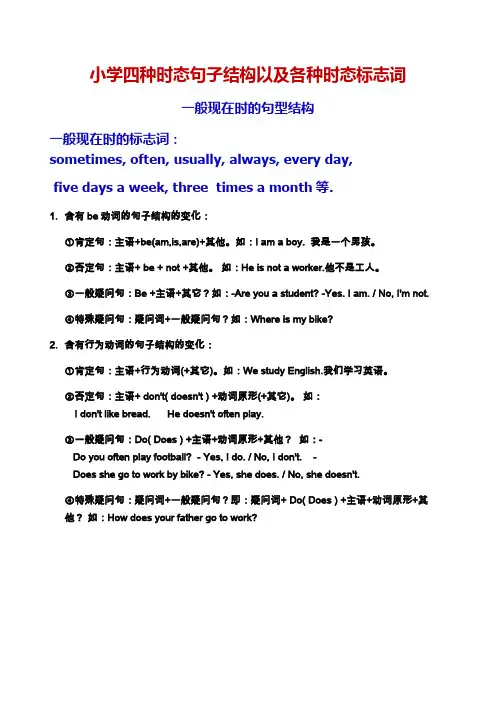
小学四种时态句子结构以及各种时态标志词一般现在时的句型结构一般现在时的标志词:sometimes, often, usually, always, every day,five days a week, three times a month等.1.含有be动词的句子结构的变化:①肯定句:主语+be(am,is,are)+其他。
如:I am a boy. 我是一个男孩。
②否定句:主语+ be + not +其他。
如:He is not a worker.他不是工人。
③一般疑问句:Be +主语+其它?如:-Are you a student? -Yes. I am. / No, I'm not.④特殊疑问句:疑问词+一般疑问句?如:Where is my bike?2.含有行为动词的句子结构的变化:①肯定句:主语+行为动词(+其它)。
如:We study English.我们学习英语。
②否定句:主语+ don't( doesn't ) +动词原形(+其它)。
如:I don't like bread. He doesn't often play.③一般疑问句:Do( Does ) +主语+动词原形+其他?如:-Do you often play football? - Yes, I do. / No, I don't. -Does she go to work by bike? - Yes, she does. / No, she doesn't.④特殊疑问句:疑问词+一般疑问句?即:疑问词+ Do( Does ) +主语+动词原形+其他?如:How does your father go to work?一般过去时标志词:yesterday, last, the day before …, ago和过去的某个时间,具体如下:(1)yesterday, yesterday morning/afternoon/evening , last week, last year, at the end of last term/week/mo nth/year等,(2)一段时间+ago如:ten years ago, five hours ago,(3)过去的某个时间,如: on January 1st,2004, in the 1980s等.1.含有be动词的句子结构的变化:⑴am 和is在一般过去时中变为was。
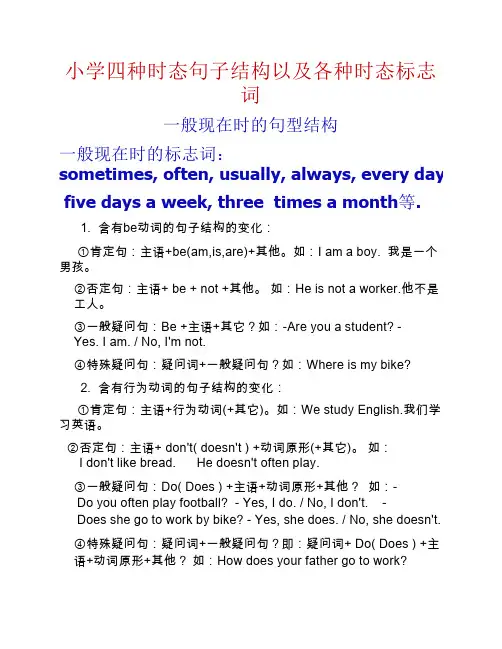
小学四种时态句子结构以及各种时态标志词一般现在时的句型结构一般现在时的标志词:sometimes, often, usually, always, every day, five days a week, three times a month等.1. 含有be动词的句子结构的变化:①肯定句:主语+be(am,is,are)+其他。
如:I am a boy. 我是一个男孩。
②否定句:主语+ be + not +其他。
如:He is not a worker.他不是工人。
③一般疑问句:Be +主语+其它?如:-Are you a student? -Yes. I am. / No, I'm not.④特殊疑问句:疑问词+一般疑问句?如:Where is my bike?2. 含有行为动词的句子结构的变化:①肯定句:主语+行为动词(+其它)。
如:We study English.我们学习英语。
②否定句:主语+ don't( doesn't ) +动词原形(+其它)。
如:I don't like bread. He doesn't often play.③一般疑问句:Do( Does ) +主语+动词原形+其他? 如:-Do you often play football? - Yes, I do. / No, I don't. -Does she go to work by bike? - Yes, she does. / No, she doesn't.④特殊疑问句:疑问词+一般疑问句?即:疑问词+ Do( Does ) +主语+动词原形+其他? 如:How does your father go to work?一般过去时句型结构一般过去时标志词:yesterday, last, the daybefore …, ago和过去的某个时间,具体如下:(1)yesterday,yesterday morning/afternoon/evening ,last week, last year, at the end of last term/we 等,(2)一段时间+ago如:ten years ago, five hours ago,(3)过去的某个时间,如: on January 1st,2004, in the 1980s等.1.含有be动词的句子结构的变化:⑴am 和is在一般过去时中变为was。
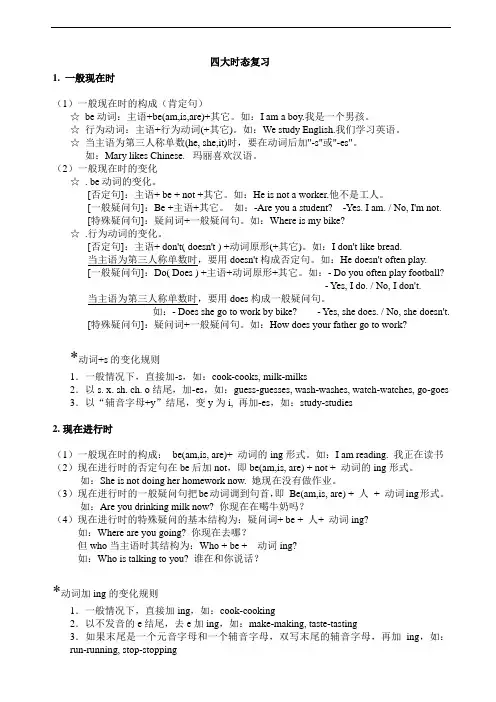
四大时态复习1. 一般现在时(1)一般现在时的构成(肯定句)☆be动词:主语+be(am,is,are)+其它。
如:I am a boy.我是一个男孩。
☆行为动词:主语+行为动词(+其它)。
如:We study English.我们学习英语。
☆当主语为第三人称单数(he, she,it)时,要在动词后加"-s"或"-es"。
如:Mary likes Chinese. 玛丽喜欢汉语。
(2)一般现在时的变化☆. be动词的变化。
[否定句]:主语+ be + not +其它。
如:He is not a worker.他不是工人。
[一般疑问句]:Be +主语+其它。
如:-Are you a student? -Yes. I am. / No, I'm not.[特殊疑问句]:疑问词+一般疑问句。
如:Where is my bike?☆.行为动词的变化。
[否定句]:主语+ don't( doesn't ) +动词原形(+其它)。
如:I don't like bread.当主语为第三人称单数时,要用doesn't构成否定句。
如:He doesn't often play.[一般疑问句]:Do( Does ) +主语+动词原形+其它。
如:- Do you often play football?- Yes, I do. / No, I don't.当主语为第三人称单数时,要用does构成一般疑问句。
如:- Does she go to work by bike? - Yes, she does. / No, she doesn't.[特殊疑问句]:疑问词+一般疑问句。
如:How does your father go to work?*动词+s的变化规则1.一般情况下,直接加-s,如:cook-cooks, milk-milks2.以s. x. sh. ch. o结尾,加-es,如:guess-guesses, wash-washes, watch-watches, go-goes 3.以“辅音字母+y”结尾,变y为i, 再加-es,如:study-studies2.现在进行时(1)一般现在时的构成:be(am,is, are)+ 动词的ing形式。
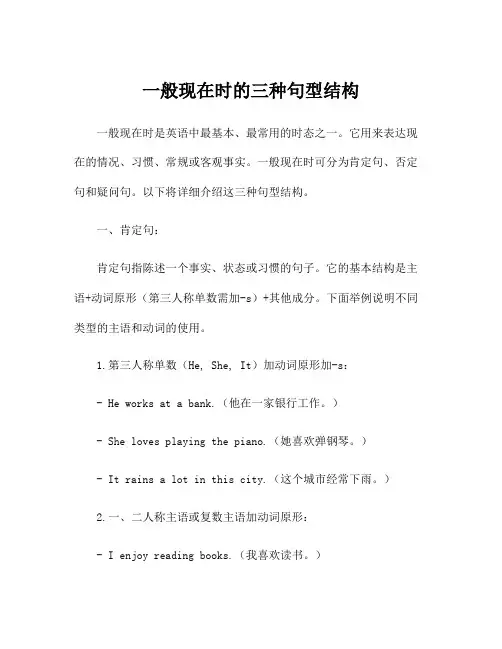
一般现在时的三种句型结构一般现在时是英语中最基本、最常用的时态之一。
它用来表达现在的情况、习惯、常规或客观事实。
一般现在时可分为肯定句、否定句和疑问句。
以下将详细介绍这三种句型结构。
一、肯定句:肯定句指陈述一个事实、状态或习惯的句子。
它的基本结构是主语+动词原形(第三人称单数需加-s)+其他成分。
下面举例说明不同类型的主语和动词的使用。
1.第三人称单数(He, She, It)加动词原形加-s:- He works at a bank.(他在一家银行工作。
)- She loves playing the piano.(她喜欢弹钢琴。
)- It rains a lot in this city.(这个城市经常下雨。
)2.一、二人称主语或复数主语加动词原形:- I enjoy reading books.(我喜欢读书。
)- We often go hiking on weekends.(我们经常在周末去远足。
)3.带有不定代词的主语加动词原形:- Everyone loves ice cream. (每个人都喜欢冰淇淋。
)- Somebody is at the door.(有人在门口。
)4.使用动词原形表达习惯或常规的肯定句:- I usually wake up at 7 o'clock in the morning.(我通常早上7点醒来。
)- They always have lunch together.(他们总是一起吃午饭。
)总结起来,肯定句的基本句型是主语+动词原形(第三人称单数时加-s)+其他成分。
根据主语的不同,动词的形式也有所不同。
二、否定句:否定句用于表示否定的情况、习惯或常规。
它的基本结构是主语+ do/does(第三人称单数)+ not +动词原形+其他成分。
1.第三人称单数前要使用does not或doesn't。
- He does not live here anymore.(他不再住在这里。
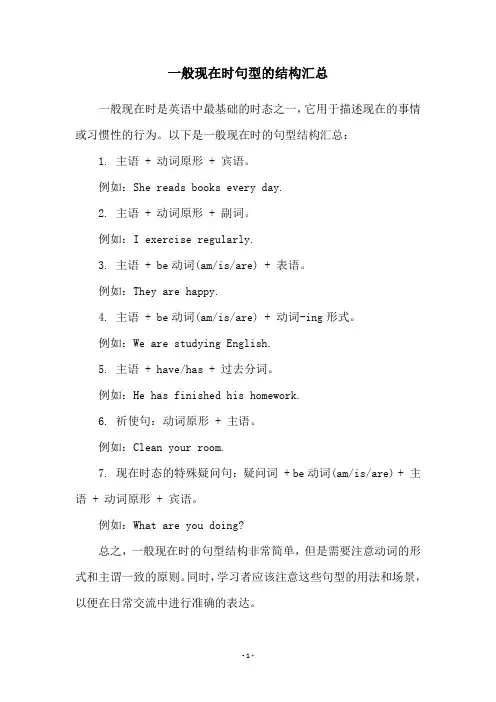
一般现在时句型的结构汇总
一般现在时是英语中最基础的时态之一,它用于描述现在的事情或习惯性的行为。
以下是一般现在时的句型结构汇总:
1. 主语 + 动词原形 + 宾语。
例如:She reads books every day.
2. 主语 + 动词原形 + 副词。
例如:I exercise regularly.
3. 主语 + be动词(am/is/are) + 表语。
例如:They are happy.
4. 主语 + be动词(am/is/are) + 动词-ing形式。
例如:We are studying English.
5. 主语 + have/has + 过去分词。
例如:He has finished his homework.
6. 祈使句:动词原形 + 主语。
例如:Clean your room.
7. 现在时态的特殊疑问句:疑问词 + be动词(am/is/are) + 主语 + 动词原形 + 宾语。
例如:What are you doing?
总之,一般现在时的句型结构非常简单,但是需要注意动词的形式和主谓一致的原则。
同时,学习者应该注意这些句型的用法和场景,以便在日常交流中进行准确的表达。
- 1 -。
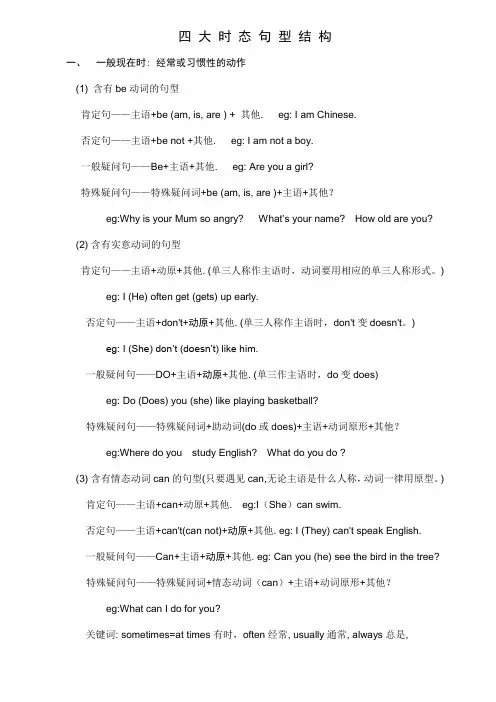
四大时态句型结构一、一般现在时: 经常或习惯性的动作(1) 含有be动词的句型肯定句——主语+be (am, is, are ) + 其他. eg: I am Chinese.否定句——主语+be not +其他. eg: I am not a boy.一般疑问句——Be+主语+其他. eg: Are you a girl?特殊疑问句——特殊疑问词+be (am, is, are )+主语+其他?eg:Why is your Mum so angry? What’s your name? How old are you? (2) 含有实意动词的句型肯定句——主语+动原+其他. (单三人称作主语时,动词要用相应的单三人称形式。
) eg: I (He) often get (gets) up early.否定句——主语+don't+动原+其他. (单三人称作主语时,don't变doesn't。
) eg: I (She) don’t (doesn’t) like him.一般疑问句——DO+主语+动原+其他. (单三作主语时,do变does)eg: Do (Does) you (she) like playing basketball?特殊疑问句——特殊疑问词+助动词(do或does)+主语+动词原形+其他?eg:Where do you study English? What do you do ?(3) 含有情态动词can的句型(只要遇见can,无论主语是什么人称,动词一律用原型。
)肯定句——主语+can+动原+其他. eg:I(She)can swim.否定句——主语+can't(can not)+动原+其他. eg: I (They) can't speak English.一般疑问句——Can+主语+动原+其他. eg: Can you (he) see the bird in the tree?特殊疑问句——特殊疑问词+情态动词(can)+主语+动词原形+其他?eg:What can I do for you?关键词: sometimes=at times有时,often经常, usually通常, always总是,every day每天, on Sunday afternoon在周日下午, five days a week一周五天, three times a month一个月三次…二、现在进行时: 正在发生的动作或存在的状态肯定句——主语+be+动词的现在分词(ing)+其他. eg: I am reading now.否定句——主语+be not+动词的现在分词(ing)+其他. eg: I am not working.一般疑问句——Be +主语+动词的现在分词(ing)+其他? eg: Are you sleeping?特殊疑问句——特殊疑问词+ be +主语+动词的现在分词(ing)+其他?eg:What are you doing?关键词:now现在, at the moment此刻, look, listen, keep quiet等提示语.三、一般将来时: 将要发生的动作(1)含有will的句型肯定句——主语+will+动词原型+其他. eg: I will call you later.否定句——主语+will not +动词原型+其他. eg: I will not go to the park.一般疑问句——Will +主语+动词原型+其他. Will you go shopping with her?特殊疑问句——特殊疑问词+will +主语+动词原形+其它?(will 可改为be going to ,疑问句中当主语是第一人称时will改为shall)(2)含有be going to 的句型肯定句——主语+be(am / is / are) + going to +动词原形+其它.否定句——主语+be(am / is / are)+not + going to +动词原形+其它.一般疑问句——Be(am / is / are) +主语+ going to +动词原形+其它?特殊疑问句——特殊疑问词+ be(am / is / are) +主语+ going to +动词原形+其它?关键词:tomorrow, next year明年, tonight今晚, this year今年, at the end of this term这学期期末, from now on从现在开始, soon一会儿马上, later后稍后,in three days三天之内, in the future未来…四、一般过去时: 过去发生的动作强调时间(1)含有be动词的句型肯定句——主语+be(was,were)+其他. eg: I was born on July.1st, 2000.否定句——主语+be(was,were) not+其他. eg: I was not born in 1999.一般疑问句—Be(was,were)+主语+其他? eg: Were you born in January?特殊疑问句—特殊疑问词+ be(was,were)+主语+其他. eg: When was he born?(2)含有实意动词过去式的句型肯定句——主语+动词的过去式+其他. eg: Lily went shopping yesterday.否定句——主语+did not+动原+其他. eg: He did not go to school today.一般疑问句——Did+主语+动原+其他? eg:Did she pass the test?特殊疑问句—特殊疑问词+did+主语+动原+其他. eg:Where did you go yesterday?关键词:yesterday昨天,last week上周, last year去年, 一段时间+ago如ten years ago十年前five hours ago五小时前, in +年/月,on+具体日期...Just now=a moment ago刚才,in the old days从前, long ago很久以前...。
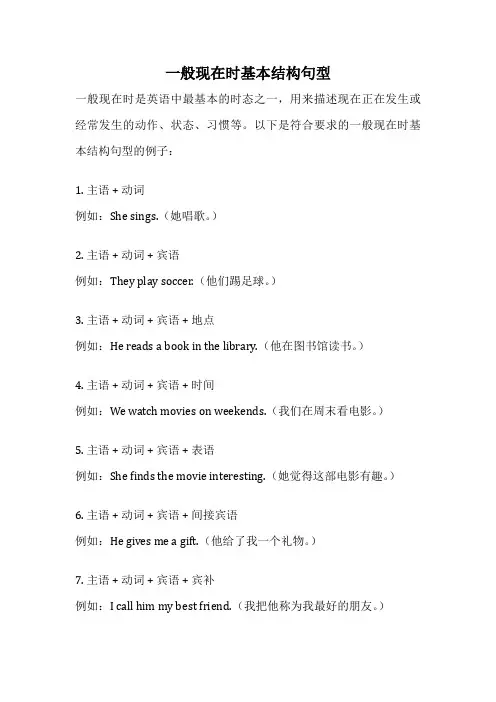
一般现在时基本结构句型一般现在时是英语中最基本的时态之一,用来描述现在正在发生或经常发生的动作、状态、习惯等。
以下是符合要求的一般现在时基本结构句型的例子:1. 主语 + 动词例如:She sings.(她唱歌。
)2. 主语 + 动词 + 宾语例如:They play soccer.(他们踢足球。
)3. 主语 + 动词 + 宾语 + 地点例如:He reads a book in the library.(他在图书馆读书。
)4. 主语 + 动词 + 宾语 + 时间例如:We watch movies on weekends.(我们在周末看电影。
)5. 主语 + 动词 + 宾语 + 表语例如:She finds the movie interesting.(她觉得这部电影有趣。
)6. 主语 + 动词 + 宾语 + 间接宾语例如:He gives me a gift.(他给了我一个礼物。
)7. 主语 + 动词 + 宾语 + 宾补例如:I call him my best friend.(我把他称为我最好的朋友。
)8. 主语 + 动词 + 宾语 + 宾语补足语例如:They made him their leader.(他们让他成为他们的领导。
)9. 主语 + 动词 + 宾语 + 宾语补足语 + 地点例如:She considers him a reliable person in the company.(她认为他是公司里一个可靠的人。
)10. 主语 + 动词 + 宾语 + 宾语补足语 + 时间例如:We elect our class monitor every semester.(我们每个学期选举我们的班长。
)11. 主语 + 动词 + 宾语 + 宾语补足语 + 表语例如:He named his dog Spot.(他给他的狗取名叫Spot。
)以上是一些符合要求的一般现在时基本结构句型的例子。

一般现在时的句型结构和用法一般现在时是英语中最基本的时态之一,用来表达经常性的动作、习惯、真理和客观事实。
它的句型结构和用法非常简单,但却是我们日常交流中最常用的时态之一。
一般现在时的肯定句结构为:主语+ 动词原形(第三人称单数加-s)+ 其他成分。
例如:I eat breakfast every morning.(我每天早上吃早餐。
)He goes to school by bus.(他乘公交车去学校。
)一般现在时的否定句结构为:主语 + do/does not + 动词原形 + 其他成分。
例如:I do not like coffee.(我不喜欢咖啡。
)She does not play basketball.(她不打篮球。
)一般现在时的疑问句结构为:Do/Does + 主语 + 动词原形 + 其他成分?例如:Do you like swimming?(你喜欢游泳吗?)Does he speak English?(他会说英语吗?)一般现在时的用法非常广泛。
首先,它用来表达经常性的动作或习惯。
比如:I brush my teeth twice a day.(我每天刷两次牙。
)They always go to the park on weekends.(他们每个周末都去公园。
)这些动作或习惯在过去、现在和将来都是存在的。
其次,一般现在时还用来表达客观事实和真理。
比如:The sun rises in the east.(太阳从东方升起。
)Water boils at 100 degrees Celsius.(水在100摄氏度沸腾。
)这些都是普遍存在的事实,不受时间的限制。
此外,一般现在时还可以用来表示现阶段的情况或状态。
比如:I am a student.(我是一名学生。
)He works as a doctor.(他是一名医生。
)这些句子描述的是现在的情况或状态,没有时间限制。
最后,一般现在时还可以用来表示将来的时间表或安排。
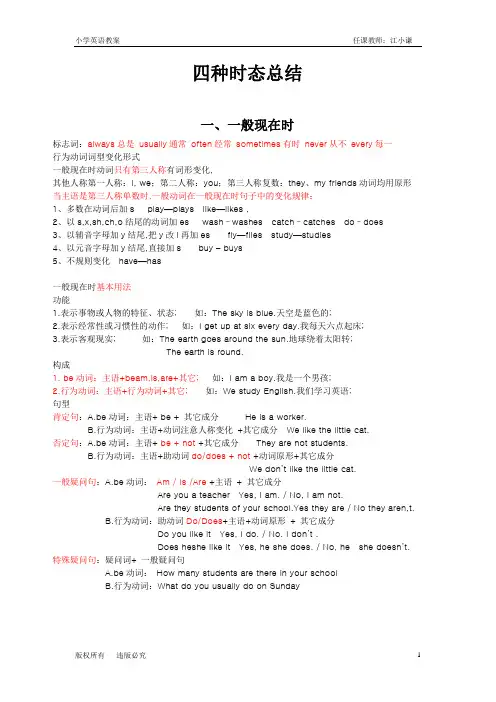
四种时态总结一、一般现在时标志词:always总是usually通常often经常sometimes有时never从不every每一行为动词词型变化形式一般现在时动词只有第三人称有词形变化,其他人称第一人称:I, we;第二人称:you;第三人称复数:they、my friends动词均用原形当主语是第三人称单数时,一般动词在一般现在时句子中的变化规律:1、多数在动词后加s play—plays like—likes ,2、以s,x,sh,ch,o结尾的动词加es wash–washes catch–catches do–does3、以辅音字母加y结尾,把y改i再加es fly—flies study—studies4、以元音字母加y结尾,直接加s buy – buys5、不规则变化have—has一般现在时基本用法功能1.表示事物或人物的特征、状态; 如:The sky is blue.天空是蓝色的;2.表示经常性或习惯性的动作; 如:I get up at six every day.我每天六点起床;3.表示客观现实; 如:The earth goes around the sun.地球绕着太阳转;The earth is round.构成1. be动词:主语+beam,is,are+其它;如:I am a boy.我是一个男孩;2.行为动词:主语+行为动词+其它;如:We study English.我们学习英语;句型肯定句:A.be动词:主语+ be + 其它成分He is a worker.B.行为动词:主语+动词注意人称变化+其它成分We like the little cat.否定句:A.be动词:主语+ be + not +其它成分They are not students.B.行为动词:主语+助动词do/does + not +动词原形+其它成分We don’t like the little cat.一般疑问句:A.be动词:Am / Is /Are +主语+ 其它成分Are you a teacher Yes, I am. / No, I am not.Are they students of your school.Yes they are / No they aren,t.B.行为动词:助动词Do/Does+主语+动词原形+ 其它成分Do you like it Yes, I do. / No. I don’t .Does heshe like it Yes, he she does. / No, he she doesn’t.特殊疑问句:疑问词+ 一般疑问句A.be动词:How many students are there in your schoolB.行为动词:What do you usually do on Sunday一般现在时动词be和have的变化形式1.动词Be 叫连系动词, 用法:第一人称单数用am,第三人称单数用is,其它人称用are;2.动词have的用法:第三人称单数用has以外,其它人称一律用have;如:注意事项 1.在英国,人们常用have got代替have,特别在疑问句和否定句中;2.当have如果不表示“有”时,构成疑问或否定句时,就借助于助动词do, does如:I have a new pen . 否:I have not a new pen. 表示有I have lunch at 12 o’clock. 否:I don’t have lunch at 12 o’clock. 表示吃二.现在进行时:标志词:now, look, listen,It’s+时间.现在进行时: 表示正在进行的、发生的动作基本结构:ambe is + 动词ingare肯定句:主语+ be动词am, are, is+ 现在分词ing+ 其他I am watching TV.否定句:主语+ be动词+ not + 现在分词ing+ 其他I am not watching TV.一般疑问句:Be动词Am, Are, Is + 主语+ 现在分词ing+ 其他Are you watching TV Yes, I am. / No, I am not.特殊疑问句:疑问词+ 一般疑问句What are you doing动词的-ing形式的变化规律:1. 直接加-ing watch—watching clean—cleaning2. 以-y结尾的动词,直接加-ing study—studying play—playing3. 以不发音的-e结尾的动词,先去-e再加-ing make—making come—coming4. 末尾只有一个元音字母和一个辅音字母的重读闭音节动词,双写末尾字母,再加-ing cut—cutting三、一般将来时的用法:表示将来某一时刻的动作或状态,或将来某一段时间内经常的动作或状态;标志词:tomorrow明天,the day after tomorrow后天,next 下一个,from now on从现在开始,in the future将来,soon不久等结构:1 beam,is ,are +going to+动词原形 2 will+动词原形“be going to+动词原形打算…”=”will+动词原形将,会…”I’m going to study tomorrow. I will study tomorrow.be going to着重于事先考虑好will 未事先考虑好----一般不用考虑肯定句:主语+ be am, are, is going to + 动词原形.主语+ will + 动词原形否定句:主语+ be am, are, is not going to + 动词原形.主语+won’t + 动词原形.一般疑问句:Be Am, Are, Is + 主语+ going to + 动词原形Will + 主语+ 动词原形特殊疑问句:疑问词+ 一般疑问句注意:will 常简略为'll,并与主语连写在一起,如:I'll,he'll,it'll,we'll,you'll,they'll;四、一般过去时标志词:yesterday昨天, last 上一个, this morning今天早上,ago以前,before 在…之前, in 2002在2002年等用法:表示过去某个时间发生的动作或存在的状态,常和表示过去的时间状语连用;也表示过去经常或反复发生的动作动词过去式变化规则:1.一般在动词末尾加-ed 如:watch-watched, cook-cooked2.结尾是e加d 如:taste-tasted3.末尾只有一个元音字母和一个辅音字母的重读闭音节,应双写末尾的辅音字母,再加-ed,如:stop-stopped4.以“辅音字母+y”结尾的,变y为i, 再加-ed,如:study-studied5.不规则动词过去式:am,is-was, are-were, do-did, see-saw, say-said, give-gave…句型:1、Be动词在一般过去时中的变化:⑴am 和is 变为was; 否定was not=wasn’t⑵are变为were; 否定were not=weren’t否定句:在was或were后加not一般疑问句:把was或were调到句首;2、行为动词在一般过去时中的变化否定句:didn’t + 动词原形如:Jim didn’t go home yesterday.一般疑问句:在句首加Did,句子中的动词过去式变回原形如:Did Jim go home yesterday 特殊疑问句:1疑问词+did+主语+动词原形如: What did Jim do yesterday2疑问词当主语时:疑问词+动词过去式如:Who went to home yesterday附录:小学常用不规则动词过去式一、不规则动词的过去式的构成1.把动词原形中的i改为a,变成过去式;如:begin—began,drink—drank,give—gave,ring—rang,sing—sang,sit—sat,s wim—swam2.把重读开音节中的i改为o,变成过去式;如:drive—drove,ride—rode,write—wrote3.改动词原形中的aw /ow为ew,变成过去式;如:draw—drew,grow—grew,know—knew,throw—threw动词show除外,show—showed4.动词原形中的e改为o,变成过去式;如:get—got,forget—forgot5.动词原形中的ee改为e,变成过去式;如:feed—fed,meet—met6.动词原形中的eep改为ept,变成过去式;如:keep—kept,sleep—slept,sweep—swept7.动词原形中的eak改为oke,变成过去式;如:break—broke,speak—spoke8.动词原形中的ell改为old,变成过去式;如:sell—sold,tell—told9.动词原形中的an改为oo,变成过去式;如:stand—stood,understand—understood10.以ought和aught结尾,且读音是〔 :t〕的过去式;如:bring—brought,buy—bought,think—thought,catch—caught,teach—taught11.以ould结尾且读音为〔ud〕的情态动词过去式;如:can—could,shall—should,will—would12.把动词原形中的o改为a,变成过去式;如:come—came,become—became13.在动词原形后加d或t变成过去式,并且发生音变;如:hear〔hi 〕—heard〔h :d〕, say〔sei〕—said〔sed〕,mean〔mi:n〕—meant 〔ment〕14.动词的过去式与动词原形一样;如:let—let,must—must,put—put,read—read〔red〕二.不规则动词表原形过去式中文释义am was 是表示存在、状态等are were 是表示存在、状态等become became 成为;变成begin began 开始break broke 打破bring brought 拿来;取来;带来build built 构筑;建造;建筑buy bought 购买;买can could 可以;能;可能;会catch caught 赶上车船等;捕获come came 来;来到cut cut 切;割;削;剪do/does did 做;干;行动draw drew 画drink drank 喝;饮drive drove 开车;驾驶eat ate 吃feel felt 感到;觉得find found 寻找;查找fly flew 飞行forget forgot 忘记;忘却get got 变得give gave 给;授予go went 去have/has had 得病;患病;有;吃;饮hear heard 听见;听说hide hid 隐藏is was 是表示存在、状态等keep kept 保持;使保持某种状态know knew 知道;了解leave left 离去;出发let let 允许;让lose lost 失去;丧失make made 使;促使;迫使;做;制作may might 可能;可以mean meant 表示……的意思;作……的解释meet met 遇见;相逢put put 放;摆;装read read /e/ 读;阅读ride rode 骑ring rang 铃响rise rose 上升run ran 跑;奔跑say said 说;讲see saw 看见send sent 发送;寄;派;遣set set 放, 置show showed 出示;给……看shut shut 关上门、盖、窗户等sing sang 唱;唱歌sit sat 坐sleep slept 睡;睡觉speak spoke 说;说话swim swam 游泳take took 搭乘;花费时间;拿走;带到teach taught 教;讲授tell told 告诉;讲述think thought 想;思考will would 将要win won 赢;获胜write wrote 书写小学英语语法词性总结一、形容词、副词的比较级和最高级的用法:当两种物体之间相互比较时,我们要用形容词或副词的比较级;当相互比较的物体是三个或三个以上时,用形容词或副词的最高级;比较级二者比较,标志词:than最高级三者以上比较,标志词:the形容词、副词的比较级和最高级的变化规律:1. 单音节形容词或副词后面直接加-er或-est tall—taller—tallest fast—faster—fastest2. 以-e结尾的单音节形容词或副词直接加-r或-st large—larger—largest nice—nicer—nicest3. 以-y结尾的形容词或副词,改-y为-i再加-er或-estbusy—busier—busiest early—earlier—earliest4. 形容词或副词是重读闭音节时,双写最后的辅音字母,再加-er或-est hot—hotter—hottest5. 多音节形容词或副词前面直接加more或most beautiful—more beautiful—most beautiful6. 以ly结尾的副词一般加more或most slowly—more slowly—most slowly7. 不规则变化good well- better-best bad badly-worse-worst little-less-leastfar-farther-further manymuch- more – most形容词、副词的比较级和最高级用法:比较级:1、形容词:物体A + am / are / is + 形容词比较级+ than + 物体BI am taller than you. This picture is more beautiful than that one.2、副词:物体A + 行为动词+ 副词比较级+ than + 物体B.He studies better than me.最高级:1、形容词:物体A + am / are / is + the + 形容词最高级+ 比较范围of + 人/物,in + 地方.I am the tallest in the class. Shanghai is one of the biggest cities in China.2、副词:物体A + 行为动词+ 副词最高级+ 比较范围of + 人/物,in + 地方.Cheetahs run fastest in the world. He studies best of us.表示两者对比相同:主语+谓语+as+形容词/副词原形+as+从句This box is as big as mine. This coat is not so/as cheap as that one.I study English as hard as my brother.英语比较级和最高级练习一1.A pig is __ than a dog.A. much heavyB. more heavierC much heavier D. more heavy2.--Which is __ season in Beijing--I think it’s spring.A. goodB. wellC. bestD. the best3. The city is becoming ______.A. more beautiful and moreB. more beautiful and beautifulC. more and more beautifulD. more beautiful and beautifuler4.Which does Alice like _____ , Chinese or ArtA. wellB. bestC. betterD. much5.The Changjiang River is one of ____ in the world.A. the longest riverB. longest riversC. the longest riversD. longer rivers6.LiMing speaks Chinese _____ better than me.A. veryB. moreC. a lot ofD. much7.There are____boys in Class Two than in Class Four.A. moreB. manyC. mostD. best8.Who has _____ oranges now, Jim, Lily or LucyA. muchB. biggestC. betterD. the most9.Mother is _____ in my family.A. busyB. busierC. the busiestD. more10.No one is _____ Lucy in the class.A. so tallest asB. as taller asC. so high asD. as tall as二写出下列形容词与副词的比较级与最高级形式:long_____ ______ wide ______ _______ fat ____ _____heavy____ ______ slow ______ _______ few____ _____brightly______ -_____ bably _____ _______ far____ _____quickly _____ ______ happy_____ -______ unhappy________三用所给词的正确形式填空:1. Of the two girls, I find Lucy the _______ clever.2. Gold黄金is ______ little useful than iron铁.3. My sister is two years _______ old than I.4. John’s parents have four daughters, and she is the _____ young child.5. The _____ cheap bags are the not usually the best ones.6. The short one is by far _______ expensive of the five.7. The boy is not so ______ interesting as his brother.8. Dick sings _____ well, she sings ______well than John, but Mary sings______wellin her class.9. She will be much ______ happy in her mew house.10. This dress is ______ that.twice, as…as…, expensive参考答案:一C D C C C D A D C D二longer longest wider widestfatter fattest heavier heaviestslower slowest fewer fewestmore brightly, most brightly worse, worstfurther,furthest more quickly, most quicklyhappier happiest unhappier unhappiest三clever lessOlder youngestCheapest the mostInteresting well, better, the bestHappier twice as expensive as二、情态动词情态动词的定义:情态动词有词义,但它不能单独作谓语,它必须和其他动词一起构成谓语;情态动词没有人称和数的变化,后加动词原形;can 能够,会may 可以shall 将,要should 应该must 必须havehasto 不得不had better 最好情态动词的用法:情态动词肯定句否定句can 主语+ can + 动词原形主语+ can + not + 动词原形may 主语+ may + 动词原形主语+ may + not + 动词原形shall 主语+ shall + 动词原形主语+ shall + not + 动词原形should 主语+ should + 动词原形主语+ should + not + 动词原形must 主语+ must + 动词原形主语+ must + not + 动词原形havehasto 主语+ havehasto + 动词原形主语+ don’tdoesn’t+havehasto + 动词原形had better 主语+ had better + 动词原形主语+ had better + not + 动词原形情态动词疑问句肯定回答否定回答can Can + 主语+动词原形Yes, ~can. No, ~can’t.may May + 主语+动词原形Yes, ~may. / Sure. No, ~may not.shall Shall + 主语+动词原形Yes, please. / All right. No, le t’s not.should Should +主语+动词原形Yes, ~should. No, ~shouldn’t.must Must + 主语+动词原形Yes, ~must. No, ~needn’t.havehasto Do does+主语+Yes, ~do does. No, ~don’t doesn’t.have to +动词原形had better ///三、名词复数规则1.一般情况下,直接加-s,如:book-books, bag-bags, cat-cats, bed-beds2.以s. x. sh. ch结尾,加-es,如:bus-buses, box-boxes, brush-brushes, watch-watches 3.以“辅音字母+y”结尾,变y为i, 再加-es,如:family-families, strawberry-strawberries4.以“f或fe”结尾,变f或fe为v, 再加-es,如:knife-knives5.不规则名词复数:man-men, woman-women, policeman-policemen,policewoman-policewomen, mouse-mice, child-children,foot-feet,tooth-teeth,fish-fish, people-people, Chinese-Chinese, Japanese-Japanese改fe为ve加s口诀1树叶半数自己黄妻子拿刀去割粮架后窜出一只狼就像小偷逃命忙2常用不规则名词复数形式foot-feet 脚man-men 男人woman-women 女人tooth-teeth 牙mouse-mice 老鼠goose-geese 鹅child-children 小孩3单复数同形fish 鱼li 里jin 斤yuan 元mu 亩sheep 羊deer 小鹿Chinese 中国人Japanese 日本人means 手段单复名词同形:中国人日本人都爱绵羊鹿和鱼.高频考点man woman 作定词修饰复数时需变为复数形式two men doctors 两位男医生many women leaders 很多女领导4只有复数形式,没有单数形式trousers 裤子clothes 衣服shorts 短裤goods 商品glasses 眼镜shoes 鞋5常用不可数名词advice 建议baggage 行李bread 面包rain 雨steel 钢gold 金sand 沙grass 草glass 玻璃oil 油paper 纸butter 黄油salt 盐beauty 漂亮change 零钱information 信息smoke water 水homework 作业cloth 布food 食品money 钱tea 茶snow 雪wealth 财富furniture 家具cotton 棉花rice 大米fruit 水果milk 牛奶四、介词口诀:介词的用法早、午、晚要用in,at黎明、午夜、点与分;年、月、年月、季节、周,阳光、灯、影、衣、冒in;将来时态in...以后,小处at大处in;有形with无形by,语言、单位、材料in;特征、方面与方式,心情成语惯用in;介词at和to表方向,攻击、位置、恶、善分;日子、日期、年月日,星期加上早、午、晚,收音、农场、值日on,关于、基础、靠、著论;着、罢、出售、偷、公、假,故意、支付、相反,准;特定时日和“一……就”,on后常接动名词;年、月、日加早、午、晚,of之前on代in;步行、驴、马、玩笑on,cab,carriage则用in;at山脚、门口、在当前,速、温、日落、价、核心;工具、和、同随with,具有、独立、就、原因;就……来说宾译主,对、有、方状、表细分;海、陆、空、车、偶、被by,单数、人类know to man;this、that、tomorrow,yesterday,next、last、one;接年、月、季、星期、周,介词省略已习惯;over、under正上下,above、below则不然,若与数量词连用,混合使用亦无关;‘beyond超出、无、不能,against靠着,对与反;besides,except分内外,among之内along沿;同类比较except,加for异类记心间;原状because of,、owing to、due to表语形容词under后接修、建中,of、from物、化分;before、after表一点, ago、later表一段;before能接完成时,ago过去极有限;since以来during间,since时态多变换;与之相比beside,除了last but one;复不定for、找、价、原,对、给、段、去、为、作、赞;快到、对、向t owards,工、学、军、城、北、上、南;but for否定用虚拟,复合介词待后言;ing型由于鉴,除了除外与包合;之后、关于、在......方面,有关介词须记全;in内to外表位置,山、水、国界to在前;五、代词的用法.形容词性物主代词my your his her its our their 名词性物主代词mine yours his hers its ours theirs反身代词myselfyourself/yourselveshimself herself itself ourselves themselves主格:一般放在句子前,做主语.宾格:一般放在动词,介词for、to、of…后.形容词性物主代词:修饰名词,放在名词前.名词性物主代词:代表名词,后不跟名词.反身代词及其一般用法反身代词表示动作回到其执行者本身用以加强语气;反身代词的分类1.第一人称单数:myself 我自己复数:ourselves 我们自己2.第二人称单数:yourself 你自己复数:yourselves 你们自己3.第三人称单数:himself 他自己herself 她自己itself 它自己复数:themselves 他们自己、她们自己、它们自己反身代词在句子中的用法1.作表语She's not herself today. 她今天跟平常真是判若两人;2.作宾语Please help yourself to some fish. 请随便吃点鱼;3.作介宾I learned English by myself. 我自学英语;4.作同位语He can do that himself. 他自己能做那件事;There be 有,表示存在;There is+单数、不可数名词There are+复数“There be” 句型结构:肯定句:“ There be+ 主语某人/ 某物+ 某地There isa boy in the room.否定句:“There be + not any+ 主语+ 某地There aren't any books on the desk. 一般疑问句:“Be is、are there +any+ 主语+ 某地“Yes , there is / are.” “No, there isn't / aren't. ”It +be谈论天气“ It's going to rain.”说到时间“It's time to go to school.”距离远近“It's far to get there.”情况程度“It's hard to learn.”六、连词的用法一、并列连词:1. and 连接单词My brother and I study in the same school.连接短语Our knowledge may come from the books and from practice.连接句子We are singing and they are dancing.2. but 但是/而是I have a pen but no pencil.or 或者Will you go there by bus or on foot3.nothing but 除了,只有I did nothing but watch it.4.or表示否则Hurry up or you will be late.5.for 表示因为He is good at math for he studies harder than others.6.still 表示后句概念由前句转折而来The weather is very cold, still we needn’t wear more clothes.7.not only…but also 不仅…而且可并列主、谓、宾、表及句子主语并列时,谓语要就近一致Not only he but also I am a teacher.8.as well as 以及,同样并列单词、短语、句子;并列主语时,动词要随前面的主语变化He works as well as he can9.either…or 既…又…,或…或…并列主、谓、宾、表及状语Either come in or go out.10.neither…nor 既不…也不并列主、谓、宾、表、状语,并列主语时,谓语就近一致Neither you nor he speaks French.12.both…and 和,既…也并列主、谓、宾及表语I can play both football and basketball.13.nor 也不,引导句子要倒装He can not speak English, nor can I.You like apples, so do I.二、从属连词:1. after 表示“时间”,在…之后After I finished the school, I became a worker in the factory.2.although/though 表示让步, “尽管”Although she is young, she knows a lot.3.as 表示时间,“当…时”,方式“象…”,原因,“由于、因为”让步,“尽管、虽然”As it was late, we must go now.4.as if/as though 表方式,“似乎、好像”He told is such a story as though he had been there before.5.as long as/so long as 表条件,“只要”As long as I am free, I’ll go to help you.6.as soon as 表时间,“一…就…”I will phone you as soon as I come back.7.because 表原因,“因为”I have to stay in bed because I am ill.8.before 表时间,“在…之前“You should think more before you do it.9.even if/ even though 表让步,“即使”You should try again even if you failed.10.hardly…when 表时间,“刚一…就”Hardly I entered the gate when the bell rang.11.if “假如”,引导条件状语从句What should I do net if the rain doesn’t stop“是否”,引导宾语从句I don’t know if he comes back or not.12.In case 表目的,“以防,以免”You should be more careful in case there is a fire.13.In order that 表目的,“为了,以便”We study hard in order that we can pass the exam.14.no matter +疑问词表让步,“无论,不管”No matter what you do, you should try your best.15.no sooner…than 表时间,“刚一…就…”No sooner had I come home than it began to rain.16.now that 表原因,“既然,因为,由于”Now that you are on duty,you should clean the classroom. 17.once 表时间,“一旦…”Once you promise , you should do it.三、其他1.since 表时间,“自从…以来”He has been in this company since he left school.表原因,“既然,由于”Since the job is dangerous, let’s do it more carefully.2.so far as/as far as 表条件,“就…而言,就…而论”As far as I know, it is easy for you to speak in English.3.so that 表目的“以便”Speak loud so that everybody can hear clearly.表结果“如此,以致”He got up so late that he missed the bus.4.than 表示比较,“比”Things were worse than we thought.5.that 无词义,引导名词性从句It is dangerous that we walk on the thin ice.引导定语从句和状语从句She hurried that she might not be late for work.6.unless 表条件,“除非,如果不”I will go to the zoo unless it rains.7.Until/till 表时间,“直到…为止”I’ll wait till he comes back.8.when 表时间,“当…时“When they got there, the train has left.9.whether “是否”引导名词性从句Whether he can some to see us is unknown.表让步,“不管/无论、是否”Whether she is ill or well, she is always happy.10.while 表时间,“当…时”While he was in Beijing, he visited the Great Wall.表让步,“尽管,既然”While I find the problems very difficult, I don’t think them insoluble.11.whenever 表时间,“无论什么时候”Whenever you meet any trouble, tell me at once.。
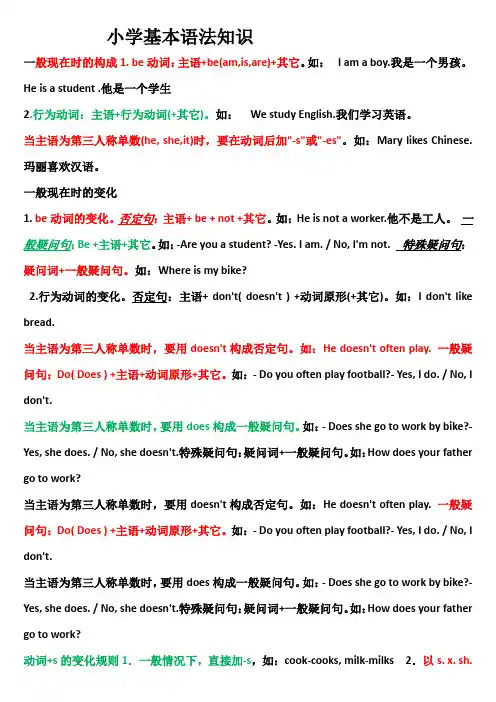
小学基本语法知识一般现在时的构成1. be动词:主语+be(am,is,are)+其它。
如:I am a boy.我是一个男孩。
He is a student .他是一个学生2.行为动词:主语+行为动词(+其它)。
如:We study English.我们学习英语。
当主语为第三人称单数(he, she,it)时,要在动词后加"-s"或"-es"。
如:Mary likes Chinese.玛丽喜欢汉语。
一般现在时的变化1. be动词的变化。
否定句:主语+ be + not +其它。
如:He is not a worker.他不是工人。
一般疑问句:Be +主语+其它。
如:-Are you a student? -Yes. I am. / No, I'm not. 特殊疑问句:疑问词+一般疑问句。
如:Where is my bike?2.行为动词的变化。
否定句:主语+ don't( doesn't ) +动词原形(+其它)。
如:I don't like bread.当主语为第三人称单数时,要用doesn't构成否定句。
如:He doesn't often play. 一般疑问句:Do( Does ) +主语+动词原形+其它。
如:- Do you often play football?- Yes, I do. / No, I don't.当主语为第三人称单数时,要用does构成一般疑问句。
如:- Does she go to work by bike?- Yes, she does. / No, she doesn't.特殊疑问句:疑问词+一般疑问句。
如:How does your father go to work?当主语为第三人称单数时,要用doesn't构成否定句。
如:He doesn't often play. 一般疑问句:Do( Does ) +主语+动词原形+其它。
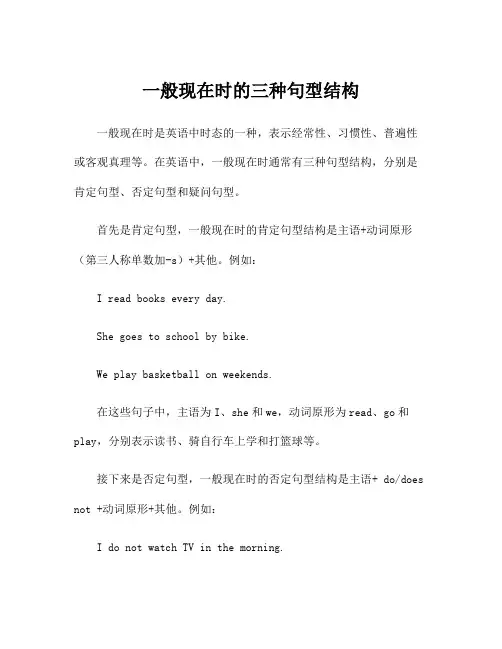
一般现在时的三种句型结构一般现在时是英语中时态的一种,表示经常性、习惯性、普遍性或客观真理等。
在英语中,一般现在时通常有三种句型结构,分别是肯定句型、否定句型和疑问句型。
首先是肯定句型,一般现在时的肯定句型结构是主语+动词原形(第三人称单数加-s)+其他。
例如:I read books every day.She goes to school by bike.We play basketball on weekends.在这些句子中,主语为I、she和we,动词原形为read、go和play,分别表示读书、骑自行车上学和打篮球等。
接下来是否定句型,一般现在时的否定句型结构是主语+ do/does not +动词原形+其他。
例如:I do not watch TV in the morning.She does not like coffee.We do not eat meat.这些句子中,do/does not分别用于否定句的主语I、she和we,动词原形为watch、like和eat,表示不看电视、不喜欢咖啡和不吃肉等。
最后是疑问句型,一般现在时的疑问句型结构是Do/Does +主语+动词原形+其他?例如:Do you go to work by bus?Does she study English every day?Do we have a meeting this afternoon?这些句子中,Do/Does用于疑问句的主语you、she和we,动词原形为go、study和have,表示乘公交车上班、每天学英语和今天下午开会等。
除了以上的句型结构外,一般现在时还可以用于表示客观真理或普遍规律。
比如:The sun rises in the east.Water boils at 100 degrees Celsius.Birds fly in the sky.这些句子中,表示客观真理或普遍规律的主语为the sun、water 和birds,动词原形分别为rises、boils和fly,表示太阳在东方升起、水在100摄氏度沸腾和鸟儿在天空飞翔等。
be动词一般现在时的四种句型结构一、肯定句结构在be动词一般现在时的肯定句中,其结构为“主语 + be动词(am/is/are)+ 表语”。
be动词的形式取决于主语的人称和数。
1. 当主语是第一人称单数I时,be动词用am。
例如:I am a student. 这里的“a student”就是表语,它可以是名词(如这个例子),也可以是形容词或者其他词类等。
比如I am happy,“happy”是形容词作表语,表示主语的状态。
2. 当主语是第三人称单数(he/she/it或者单个的人名、事物名等)时,be动词用is。
例如:He is a doctor. 再如The book is interesting. “the book”是第三人称单数的主语,“interesting”是形容词作表语。
根据统计,在日常英语表达中,大约30%的be动词一般现在时肯定句的主语为第三人称单数形式。
3. 当主语是第二人称(you)或者复数(we/they或者复数的名词等)时,be动词用are。
例如:You are my friends. 又如They are workers. 在一些语言调查中发现,以第二人称和复数主语为主的be动词一般现在时肯定句在口语交流中占比接近40%。
二、否定句结构be动词一般现在时的否定句结构是“主语 + be动词(am/is/are)+ not + 表语”。
1. 如果主语是I,be动词am和not的缩写形式为I'm not。
例如:I'm not a lazy person.2. 当主语是第三人称单数时,is和not缩写为isn't。
例如:He isn't at home today.3. 对于主语是you、we、they或者复数名词时,are和not缩写为aren't。
例如:They aren't in the classroom. 在书面英语中,使用完整形式(如is not、are not等)和缩写形式都较为常见,而在口语中,缩写形式的使用频率更高,大约能占到否定句表达的70%。
英语一般现在时的句子结构1.主语+ 动词原形+ 其他(She eats an apple every day.)2.主语+ 动词原形+ 其他(He plays basketball with his friends.)3.主语+ 动词原形+ 其他(They watch movies on weekends.)4.主语+ 动词原形+ 其他(I go to school by bus.)5.主语+ 动词原形+ 其他(She speaks Spanish fluently.)6.主语+ 动词原形+ 其他(He reads books in the library.)7.主语+ 动词原形+ 其他(The dog barks loudly.)8.主语+ 动词原形+ 其他(The sun rises in the east.)9.主语+ 动词原形+ 其他(We play soccer after school.)10.主语+ 动词原形+ 其他(She dances at the party.)11.主语+ 动词原形+ 其他(He runs in the park every morning.)12.主语+ 动词原形+ 其他(They study English at school.)13.主语+ 动词原形+ 其他(I drink coffee in the morning.)14.主语+ 动词原形+ 其他(The cat sleeps on the couch.)15.主语+ 动词原形+ 其他(The birds sing in the trees.)16.主语+ 动词原形+ 其他(He drives a car to work.)17.主语+ 动词原形+ 其他(She teaches math in the classroom.)18.主语+ 动词原形+ 其他(We swim in the pool on hot days.)19.主语+ 动词原形+ 其他(He checks his email every hour.)20.主语+ 动词原形+ 其他(They clean their room every Saturday.)21.She goes to school every day.22.They watch TV in the evening.23.He plays football on weekends.24.I love to eat pizza for dinner.25.We learn English at school.26.She brushes her teeth before bed.27.He reads books in his free time.28.They speak Spanish fluently.29.I listen to music while doing homework.30.She dances beautifully at the party.31.We drink coffee in the morning.32.He cooks dinner for the family.33.They walk their dog in the park.34.I study for exams every day.35.She watches movies on weekends.36.He helps his mom with chores.37.We play video games together.38.She goes shopping with her friends.39.They visit their grandparents every month.40.I swim in the pool during summer.41.She reads books every day.42.They go to school by bus.43.I play basketball on weekends.44.He watches TV in the evening.45.We eat breakfast together.46.You listen to music while studying.47.The dog barks when someone knocks on the door.48.She always arrives early for meetings.49.My parents work in the city.50.The sun rises in the east.51.Birds sing in the morning.52.The baby sleeps in the afternoon.53.He drinks coffee in the morning.54.I walk to the park after dinner.55.The train departs on time.56.She smiles when she sees her friends.57.They play soccer in the park.58.The cat chases the mouse.59.We study for exams together.60.He teaches English at the university.61.主语+ 动词原形(第三人称单数需加s/es)+ 其他62.主语+ 动词原形(第三人称单数需加s/es)+ 其他63.主语+ be动词(am/is/are)+ 其他64.主语+ be动词(am/is/are)+ 形容词/名词/副词等65.主语+ have/has + 过去分词66.主语+ have/has + been + 现在分词/形容词/名词等67.主语+ have/has + been + 动词-ing68.主语+ have/has + 动词过去分词69.主语+ 动词原形(第三人称单数需加s/es)+ 时间状语70.主语+ be动词(am/is/are)+ 动词-ing71.主语+ 动词原形(第三人称单数需加s/es)+ 双宾语72.There be结构(There is/are)+ 主语73.主语+ do/does + 动词原形74.主语+ do/does not + 动词原形75.主语+ do/does + 主语补语76.主语+ do/does not + 主语补语77.疑问句结构(Yes/No问句)78.特殊疑问句结构(问句词+ 助动词+ 主语+ 其他)79.倒装句结构(动词/助动词+ 主语+ 其他)80.主语+ will/shall + 动词原形81.She plays basketball every evening.82.I enjoy reading books in my free time.83.He goes to the gym twice a week.84.They watch movies on weekends.85.We listen to music while cooking.86.The cat sleeps all day long.87.My parents work in the hospital.88.She teaches English at a language school.89.I play the guitar in a band.90.He always eats breakfast before work.91.They travel to different countries every summer.92.We visit our grandparents on holidays.93.The dog barks at strangers.94.She studies hard for exams.95.He speaks three languages fluently.96.I take the bus to school every morning.97.They walk their dog in the park.98.The students read books in the library.99.She dances ballet on weekends. 100.We go shopping at the mall.101.I eat breakfast every morning.102.She works at a bank.103.They play soccer on the weekends. 104.He watches TV after dinner.105.We go to the gym three times a week. 106.The cat sleeps in the sun.107.You drink coffee in the afternoon. 108.She reads books in her free time. 109.He listens to music while studying. 110.They walk to school every day. 111.I like to watch movies on Fridays. 112.She dances in the living room.113.We visit our grandparents on holidays. 114.He plays the guitar in a band.115.They speak Spanish fluently. 116.She teaches English to children. 117.I work from home on Mondays. 118.He cooks dinner for his family. 119.They go for a run in the park. 120.She practices yoga in the morning.。
英语各种时态的概念和句型结构一、一般现在时1、概念:表示经常性、习惯性的动作。
2、句型结构(1)be(am,is,are)动词陈述肯定句:主语+be(am,is,are)+其它。
陈述否定句:主语+be(am,is,are)+not+其它。
一般疑问句:Be(am,is,are)+主语+其它特殊疑问句:疑问词+一般疑问句Who are they反意疑问句:肯定陈述句+be(am,is,are)+not+主语(相应的代词)Tom is a doctor, isn’t he否定陈述句,+be(am,is,are)+主语(相应的代词)Tom isn’t a doctor , is he(2)实义动词陈述肯定句:其他人称:主语+v.原形+其它。
We go to the beach every Sunday.第三人称单数:主语++其它。
Sally does her homework every day.陈述否定句:其他人称:主语+don’t+v.原形+其它。
We don’t go to the beach every Sunday.第三人称单数:主语+doesn’t+v.原形+其它。
Sally doesn’t do her homework every day.一般疑问句:其他人称:Do+主语+v.原形+其它Do we go to the beach every Sunday第三人称单数:Does+主语+v.原形+其它Does Sally do her homework every day特殊疑问句:疑问词+一般疑问句其他人称:Where do you go every Sunday第三人称单数:What does Sally do every day反意疑问句:肯定陈述句,+don’t/doesn’t+主语(相应的代词)其他人称:We go to the beach every Sunday, don’t we第三人称单数:Sally does her homework every day, doesn’t she否定陈述句,+do/does+主语(相应的代词)其他人称:We don’t go to the beach every Sunday , do we第三人称单数:Sally doesn’t do her homework every day , does she二、一般过去时1、概念:表示过去某个时间发生的动作或存在的状态。
一般现在时的四大句型一般现在时是英语中最基础的时态之一,它用来描述现在正在发生的事情、经常发生的事情或者普遍真理。
在英语中,一般现在时有四种基本的句型,分别是肯定句、否定句、疑问句和特殊疑问句。
下面我们来看一下这四种句型的具体用法和例句。
一、肯定句肯定句是最基本的句型,它用来描述现在正在发生的事情或者经常发生的事情。
肯定句的结构是主语+谓语动词+其他成分。
谓语动词要用原形,即不带s或es的形式。
例句:1. I love reading books.(我喜欢读书。
)2. She plays basketball every day.(她每天都打篮球。
)3. They live in a big house.(他们住在一座大房子里。
)二、否定句否定句用来表示否定的意思,它的结构是主语+do/does+not+谓语动词+其他成分。
其中,do/does是助动词,用来构成否定句。
谓语动词仍然要用原形。
例句:1. I do not like coffee.(我不喜欢咖啡。
)2. She does not speak Chinese.(她不会说中文。
)3. They do not have a car.(他们没有车。
)三、疑问句疑问句用来询问信息或者确认某件事情是否属实。
疑问句的结构是助动词+主语+谓语动词+其他成分。
其中,助动词要根据主语的人称和数来选择,谓语动词仍然要用原形。
例句:1. Do you like pizza?(你喜欢披萨吗?)2. Does she live in New York?(她住在纽约吗?)3. Do they play soccer on weekends?(他们周末踢足球吗?)四、特殊疑问句特殊疑问句用来询问特定的信息,如时间、地点、原因等。
特殊疑问句的结构是疑问词+助动词+主语+谓语动词+其他成分。
疑问词包括what、where、when、why、how等。
例句:1. What do you do for a living?(你是做什么工作的?)2. Where does she usually go on vacation?(她通常去哪里度假?)3. Why do they always arrive late?(他们为什么总是迟到?)以上就是一般现在时的四种基本句型,它们是英语学习的基础,掌握好这些句型,可以帮助我们更好地表达自己的意思,也能更好地理解别人的话。
一般现在时的三种句型结构一般现在时是英语中最基本的时态之一,常用于描述客观事实、习惯性动作、科学原理等。
以下是列举的三种句型结构:1. 主语 + 动词这种句型结构最简单直接,用于陈述客观事实。
例句:- 猫喜欢捉老鼠。
(Cats catch mice.)- 太阳从东方升起。
(The sun rises in the east.)- 水沸腾时会产生蒸汽。
(Water boils and produces steam.)2. 主语 + 动词 + 宾语这种句型结构用于表达主体的动作对客体的影响或动作的直接对象。
例句:- 我喜欢吃巧克力。
(I like eating chocolate.)- 学生们阅读英语书籍。
(Students read English books.)- 他们每天锻炼身体。
(They exercise every day.)3. 主语 + 动词 + 宾语 + 宾语补足语这种句型结构用于描述动作对宾语的性质、状态、特征等进行补充说明。
例句:- 她把房间打扫得干干净净。
(She cleaned the room spotlessly.)- 他使我感到惊讶。
(He made me surprised.)- 妈妈把饭做得很好吃。
(Mom cooked the meal deliciously.)除了以上列举的三种句型结构,还有其他一些常用的句型结构,如:- 主语 + 动词 + 宾语 + 宾语补足语 + 表语- 主语 + 动词 + 宾语 + 宾语补足语 + 宾语补足语补足语总结起来,一般现在时的句型结构多种多样,可以根据需要进行灵活运用,以准确表达所要表达的信息。
一般现在时的三种句型结构一般现在时是英语中最基本的时态之一,用来表示当前的行为、习惯和事实。
在使用一般现在时时,我们通常可以采用三种句型结构,包括肯定句、否定句和疑问句。
肯定句的结构是主语+动词原形(第三人称单数时加-s/-es)+其他。
例如:I play the guitar every evening.(我每天晚上弹吉他。
)否定句的结构是主语+动词原形(第三人称单数时加-s/-es)+not +其他。
例如:She does not like coffee.(她不喜欢咖啡。
)疑问句的结构是助动词do/does +主语+动词原形+其他?例如:Do you speak English?(你会说英语吗?)下面我们将分别对这三种句型结构进行更详细的讨论。
肯定句:在肯定句中,我们通常通过主语加动词原形来表示一个现在时的动作或状态。
例如:They study for their exams every night.(他们每天晚上为考试学习。
)在这个句子中,“They”是主语,“study”是原形动词,表示现在时的动作,“for their exams every night”是其他。
这个句子表达了一个事实,即“他们每天晚上学习”。
另外,当主语是第三人称单数时,动词需要加上-s/-es结尾。
例如:He works at a company.(他在一家公司工作。
)否定句:在否定句中,我们通常通过在动词后面加上“not”来表示否定的意思。
例如:I do not like to eat spicy food.(我不喜欢吃辣食。
)在这个句子中,“do not”是否定形式的助动词,“like”是动词原形,“to eat spicy food”是其他。
这个句子表达了一个否定的事实,即“我不喜欢吃辣食”。
另外,当主语是第三人称单数时,动词需要在动词原形后加上“-s”或“-es”。
例如:She does not watch TV in the evening.(她没有在晚上看电视。
小学英语一般现在时的句型结构
1.肯定句构成:主语+动词 (注意人称变化) +其它成分
I have a dog. We like the little cat. She sings well.
2.否定句构成:
行为动词的否定句:主语+助动词(do/does) + not +动词原形+其它成分
He dosen’t have a dog. He isn’t young. We don’t like the little cat.
3.一般疑问句:
A.行为动词的一般疑问句:助动词(do/does)+主语+动词原形 + 其它成分
Do you like it? Yes, I do. / No. I don’t . Does he(she) like it? Yes,
he( she )does. / No, he ( she )doesn’t.
B. 动词BE 的一般疑问句Am / Is /Are +主语 + 其它成分
Are you a teacher? Yes, I am. / No, I am not.
Is he your teacherYes,he is No,he is not.
4.特殊疑问句:特殊疑问词
What do you usually do on Sunday?
专项语法练习(一般现在时)
一、填写正确形式
1.We?often___________(play)?on?the?playgound.
2.__________you?_________(brush)?your?teeth?every?morning.?
3.?What____?(do)?he?usually?_____(do)?after?school??
4.Danny?_______(study)?English,?Chinese,?Maths,?Science?and?Art?at?scho
ol?
5.?Mike?sometimes?__________(go)?to?the?park?with?his?sister.?
6.________?Mike________(read)?English?every?day??
7.What?time?____his?mother_________(teach) English??
8.W e____?(not?watch)?TV?on?Monday.?。